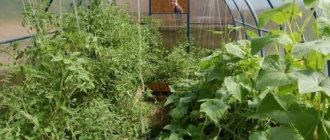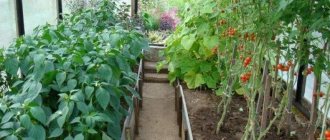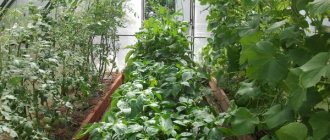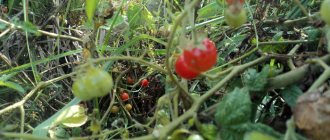Author's rating
Author of the article
Yakov Pavlovich
Professor, Head of the Department of Vegetable Growing
Articles written
153
Eggplants and peppers are unpretentious plants, and caring for them is not much different. For this reason, they can grow in the same bed. This allows, by growing eggplants and peppers in the same greenhouse or garden bed, to obtain high yields of both crops. It’s just important to plant and care for these vegetables correctly; effectively combat pests and diseases (which are also similar in these plants).
Comparative characteristics of vegetables for the greenhouse
To place vegetables in one greenhouse, you need to know their characteristics, whether they are compatible in terms of temperature, humidity, and soil composition.
Peppers and eggplants have similar growing conditions. They coexist peacefully because they have in common the following indicators:
- high air and soil humidity, up to 80 and 70 percent, respectively;
- air temperature not lower than 20 - 25 degrees;
- soil acidity is normal or slightly increased;
- The ripening period of crops reaches four months from the date of appearance of the first shoots.
It is better to plant eggplants and peppers in a greenhouse, because in open ground they may not ripen under unfavorable climatic and weather conditions.
Other "neighbors"
When planting vegetables in the greenhouse, plant lettuce next to it: the most tender greens will be an excellent vitamin supplement for the May table and will not take up much space in the greenhouse. Basil, spinach, radishes, and onions will be excellent neighbors for them.
Eggplants love proximity to peas and beans, so you can allocate some space for them too. grown in the greenhouse , which is also early ripening and cannot interfere with the development of eggplants.
Don’t forget about dill, parsley, mustard, and other greens, which will not only decorate the table, but also repel pests and enrich the soil.
Preparing seedlings for the greenhouse
Pepper and eggplant seeds begin to be sown at the end of February. In March it is too late to do this - they will not have time to produce ripe fruits in the fall.
Preparing the seeds for planting
After checking the germination of the seed material, it is first soaked in a solution of potassium permanganate for twenty minutes, then in the growth stimulator Epin or Zircon. It is enough to keep the seeds in the stimulating liquid for eighteen hours. At the next stage, the seed is placed first in warm water for a day, and then in the refrigerator for hardening.
Knowing how difficult it is to grow peppers and eggplants, the seeds are treated with air bubbles, or bubbling.
After placing the vegetable seeds in a container of warm water, lower the aquarium compressor into it. The procedure takes half an hour. Now the seeds are saturated with oxygen, and strong, healthy plants will emerge from them. It remains to be considered so that planting and care are carried out correctly.
Proper preparation of soil and containers
Deep containers, pre-steamed, are filled with nutritious loose soil. For peppers and eggplants, it is important that the soil is not overly acidic. Therefore, the best option would be a mixture of peat and humus, taken in equal quantities along with sawdust. Wood waste can be replaced with coarse river sand. Adding ash will make the soil crumbly and airy. Phosphate fertilizer will saturate the soil mixture with useful substances.
Before sowing vegetables for seedlings, the soil is spilled with boiling water for disinfection. Roasting it in the oven will also be effective. Such actions will allow the seedlings not to be infected by pathogenic fungi and bacteria. After disinfection, be sure to leave the soil in the open air to saturate it with beneficial microorganisms.
Planting seeds
Planting begins a week after the preparatory work. Place the hatched seeds at a distance of one and a half centimeters on the soil of the container, covering them with earth in a layer of one and a half to two centimeters. You can sow eggplants next to the peppers. Be sure to spill the soil with warm water after sowing.
For quick germination, containers are covered with polyethylene film on top and placed in a warm, sunny place. The mini greenhouses are ventilated daily, making sure there are no drafts.
After emergence of seedlings, the covering material is removed. As soon as two to four true leaves are formed, the eggplant and pepper seedlings are plucked.
Seedling care consists of:
- watering with warm, settled water;
- carefully loosening the soil in pots;
- feeding with fertilizers containing nitrogen;
- spraying with growth stimulants;
- humidify the air using a spray bottle.
See also
Why do peppers rot and turn black on a bush in a greenhouse and what to doRead
Strong seedlings are the key to a good quality harvest of peppers and eggplants.
First feeding
It should be carried out when the first inflorescences begin to form, that is, approximately ten days after planting. In this case, fertilizing with a high content of nitrogenous elements will be needed. For example, you can use an herbal infusion; it must be diluted with water in a ratio of one to ten. For each bush you need to allocate a liter. You can also use a solution containing mullein, bird droppings, or a universal complex mineral fertilizer with a predominance of nitrogenous elements.
Preparing seedlings and greenhouse for planting
Planting peppers and eggplants in a greenhouse is the same as in open ground. The seedlings are gradually hardened by taking them out onto the balcony or veranda, first for several hours, then increasing the time. Hardening can be carried out by lowering the air temperature in the room. At the same time, the amount of watering is reduced. A week before transplanting into the greenhouse, eggplants and peppers are sprayed with Bordeaux mixture. To carry out the procedure, fifty grams of the substance are diluted in ten liters of warm water. Such preventive procedures will reduce the risk of fungal diseases in greenhouse conditions.
Planting seedlings requires preparing a greenhouse:
- To create a high temperature in them, the room is filled with hot manure, starting at the end of February.
- The manure is heated with hot water and quicklime, pouring it into special nests.
- As soon as all layers of manure are warmed up, it is mixed.
- Distribute the manure along the walls of the room, compacting it well.
- The outer part of the greenhouse, covered with mats, heats up well, which will help the peppers and eggplants in the greenhouse to successfully bear fruit in the future.
- The settled manure is covered with a layer of earth. After two days, experts advise, plant the grown vegetable seedlings.
After carefully removing the plants from the container, lower them into specially prepared holes. Planting in the greenhouse occurs earlier than in the garden. There are certain requirements for seedlings:
- Seedlings should be up to fifteen to twenty centimeters high, with a strong stem.
- Eggplants - with six or more true leaves. Pepper seedlings have up to ten leaves and several flower ovaries.
- The age of eggplant seedlings ready for planting in open ground, as in a greenhouse, is seventy days. In this they are compatible with peppers.
Properly prepared seedlings will later delight you with healthy, tasty fruits.
Planting schemes for drip irrigation
For moisture-loving eggplants, drip irrigation is an excellent option, but they cannot tolerate flooding. Therefore, modern summer residents, in order to guarantee a harvest in their plantings, try to organize a drip irrigation system for moisture-loving crops on their plots. At the same time, the eggplant planting scheme also has to be changed:
- When placing eggplants on narrow beds of 40 - 50 cm, lay one drip tape. Place it along the row, as close to the stems as possible.
- On medium beds, allowing you to plant eggplants in 2 rows according to the scheme: between plants 35 - 40; between the rows 50 - 60 cm, lay 2 drip irrigation tapes.
- Wide ridges (from 1 to 1.5 cm) allow you to plant three rows according to the following scheme: 35 - 40 between plants; between rows 50 - 60 cm, and, accordingly, lay drip tape along each row.
The square-nest method of planting also allows the use of drip irrigation according to the following scheme: 90 - 100 X 40 -50 cm. A drip tape is laid along the resulting rows.
Dates and patterns for planting peppers and eggplants
The grown seedlings of vegetable crops begin to be replanted in early May. The beds are prepared in advance. The depth of the planting holes reaches no more than fifteen centimeters. Peppers should be planted next to each other no closer than forty or fifty centimeters. Eggplants are planted at a distance of sixty centimeters.
The basic rules for planting seedlings include:
- adding humus and wood ash to the holes;
- immersion of sprouts until the first true leaf;
- planting seedlings in the evening;
- watering each bush with two to three liters of water.
It is better to plant six eggplants and peppers per square meter. Then they will have enough nutrients, moisture and air. You can determine at what distance to plant depending on the area of the room. But dense plantings will lead to a decrease in yield.
We must not forget that the compatibility of vegetables only applies to sweet varieties of pepper. It is better to plant bitter peppers separately, since after cross-pollination the taste of the sweet fruits will be disrupted. They will become very bitter.
What can you plant next to - mixed plantings
Eggplants are not fans of neighbors; it is not advisable to grow them next to other crops. They feel more or less tolerable next to tomatoes or peppers, but the plants do not want to coexist with cucumbers at all. If eggplants are grown next to tall varieties of tomatoes, they should be planted on the side of the greenhouse where there is the most sun.
Eggplants can be planted in beds where melons and legumes previously grew. If nightshades previously grew in this place, then the purple vegetable will not feel well - it should be planted on such a ridge no earlier than after 3 years. They do well growing in soil where onions, carrots, and early cabbage were previously cultivated.
Recommendations for caring for peppers and eggplants in a greenhouse
After planting vegetables, you need to properly care for them. Competent care consists of the following techniques:
- Water vegetable crops frequently, monitoring the condition of the top layer of soil and preventing it from drying out.
- Fertilizers are applied five times during the growing season of vegetables. The first time, it is enough to water with diluted mullein in a ratio of 1:5 or bird droppings - 1:15. Subsequently, mineral fertilizers are added - ammonium nitrate, superphosphate, potassium salt.
- Tall varieties of peppers require staking, and eggplants in the greenhouse require pinching.
- Regularly loosen the soil around vegetable bushes to a shallow depth.
Caring for warm-season crops is not difficult. It is the same as when growing peppers and eggplants in open ground.
But for plants indoors, especially if peppers and eggplants are grown in a polycarbonate greenhouse, it is important to maintain the temperature regime. The temperature should not exceed 27 degrees, otherwise the vegetable leaves will get burned.
Ventilating plants will cool the hot air and have a positive effect on pollination of bushes. To speed up pollination, shake the plants every morning. Insects that are regularly released into the greenhouse will also help: wasps, bees, bumblebees.
Many people wonder whether it is possible to plant vegetables nearby. Sweet peppers and eggplants get along well. But I often plant bitter varieties in garden beds. Planting eggplants in open ground is not advisable. This vegetable grows well only in warm climate zones.
See also
Characteristics and description of California miracle pepper and its yieldRead
Growing peppers and eggplants in a greenhouse is always successful and brings rich harvests of vegetables.
Suitable varieties
Varieties are selected so that the following compatibility parameters coincide as much as possible:
- bush height;
- flowering and harvest period;
- irrigation system and other agrotechnical measures.
On a note! You cannot plant sweet and bitter pepper varieties in the same greenhouse; cross-pollination will occur. Eggplants can be grown with hot peppers, but it is necessary to maintain a distance of 2 meters between the beds.
Plants should receive the same amount of light; varieties with the same height of an adult bush should be planted in the greenhouse.
Vegetable plant diseases
The compatibility of peppers and eggplants is even that they are susceptible to the same diseases:
- Blackleg is recognized by the thinning and rotting of the root part of the stem. The disease manifests itself if the distance between plants is not maintained when plantings are dense. Rainy weather and sudden temperature changes contribute to the development of pathological symptoms. Plants can be cured by spraying with chemicals such as Fitoverm. This method will also help: sprinkle the ground with wood ash or crushed charcoal. Use watering the soil with a solution of baking soda.
- Wilting and yellowing of the lower leaves of plants is observed in greenhouses, but the disease is rarely seen in eggplants in open ground. The spores of the fungus in the soil spread quickly and persist for a very long time. Improper care contributes to the development of signs of the disease. Infection can be prevented by creating optimal conditions for the development of vegetable crops and preliminary disinfection of the soil.
- Viral pathology - mosaic - is manifested by a peculiar coloring of the leaves. The pattern is obtained from a combination of dark and light areas of the surface of the sheet plate. The disease spreads quickly, infecting all plants in the greenhouse. The disease affects seeds, so they must be disinfected before planting.
- Root rot covers the underground parts of plants. The shoots begin to wither and do not bear fruit. If therapeutic measures are not taken, then vegetable crops die. Spraying them with phytoncides will save them.
- Late blight appears as brown spots in the form of hard rot on the fruit. As the disease progresses, it turns vegetables into mush. Before planting eggplants, peppers, and seedlings, they are treated with Bordeaux mixture and copper oxychloride solution. Spray three times per season.
Peppers and eggplants are susceptible to diseases if they are not properly cared for and if inappropriate growing conditions are created for them.
About care
Loosening the soil around crops is not recommended. But if such a need arises, you need to do it very carefully. After all, their root system has a superficial type of location, that is, it is very close to ground level and is quite easily damaged when loosening.
To maintain the required level of air exchange, as well as protect the plantings from weeds, you can resort to mulching. You can mulch with these materials:
1) Sawdust;
2) Dry straw;
3) Dried cut grass;
4) Peat.
The better the quality of the mulching material, the more beneficial properties it will bring. Mulching will also help retain moisture in the soil.
Pests of peppers and eggplants - how to destroy them
Among the pests, aphids often enter the greenhouse. Clusters of miniature insects are visible on young leaves. Feeding on juices, aphids can move from one plant to another. This is how all vegetables are infected in open ground. They fight the pest with the help of Pirimicarb, and include Karbofos in preventive measures.
The Colorado potato beetle loves to feast on eggplants, destroying the leaves and eating the ovaries. The insecticidal drug Prestige completely copes with the pest.
Due to stagnation of air in the greenhouse and high humidity, spider mite activity increases. It can be detected by the web entwining the lower leaves of peppers and eggplants. Among folk remedies, an infusion made from onions, garlic, with the addition of liquid soap will be effective. All ingredients are diluted in a bucket of water and sprayed on infected plants.
A parasite of locusts, the spank beetle damages the leaves of vegetables in greenhouses. To get rid of the beetle, it is collected from plants, pollinated or sprayed with insecticides.
If mole crickets get into the greenhouse, it will be noticeable by the passages they dig in the ground. By gnawing plant stems, insects contribute to the death of vegetables. To save greenhouse crops, an infusion of hot pepper (150 grams per bucket of water) is poured into the holes made by mole crickets. To prevent pest attacks, the soil in the greenhouse is sprayed with the drug Thunder.
The compatibility of heat-loving vegetables contributes to their successful cultivation. For peppers and eggplants, the best conditions will be greenhouses, where they are not subject to weather and climate disasters. Indoors, caring for plants will be convenient and without extra costs.
Caring for adult specimens
The point of caring for adult plants is to maintain the necessary conditions for their life. Namely: 1) The required percentage of air humidity;
2) Required air temperature;
3) The required landing pattern;
4) watering mode;
5) Application of fertilizing and fertilizers.
If you carry out care procedures correctly and in a timely manner, the plants will give you an abundant and tasty harvest.
During hot summer days, it is important not to let the plants overheat. Because at temperatures of thirty degrees or more, the pollen of crops becomes sterile and because of this, even self-pollinating varieties will not be able to form ovaries. If you want to increase the yield level, then you need to shake the plant bushes a little every two to three days to ensure that they pollinate naturally.
Second feeding
The second feeding is carried out at the time when the crop begins to bear fruit. It must be of the root application type. During this period, plants really need potassium substances. After all, potassium plays a very important role in the formation and further development of vegetable fruits. You can purchase universal complex fertilizers in which the potassium element will predominate. Or you can make the mixture yourself, for this you will need:
1) Ten grams of potassium chloride;
2) Thirty grams of superphosphate;
3) Ten liters of water.
All this needs to be thoroughly mixed and allocated a liter of solution for each bush.











